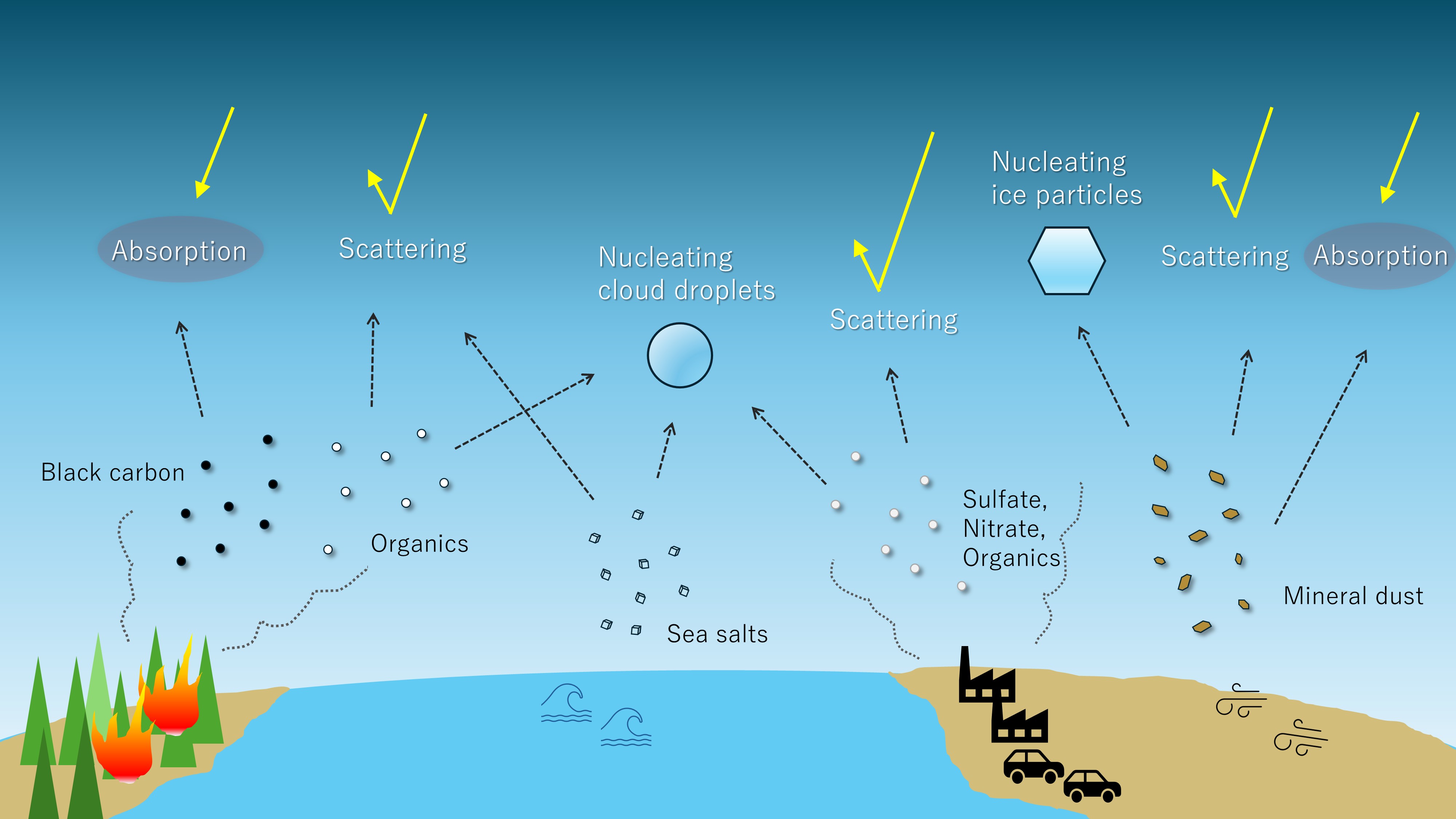Atmospheric aerosol particles comprise sulfates, nitrates, organic matter, black carbon (soot), mineral dust, sea salt, and their mixtures. This article discusses the climate impacts of particulate matter (Fig. 1) from a physical science perspective, focusing on topics relevant to research themes in our laboratory.
Atmospheric aerosols influence Earth’s radiation budget through aerosol-radiation interactions, involving scattering and absorption of solar radiation1. Sulfate aerosols predominantly scatter solar radiation back to space with minimal absorption, causing cooling of the atmosphere-ocean system. In contrast, black carbon strongly absorbs solar radiation, heating the surrounding atmosphere. While tropospheric black carbon warms the atmosphere-ocean system, stratospheric black carbon may cause net cooling of the climate system by heating the stratosphere while reducing incoming solar radiation to lower layers2.
Mineral dust, globally the most abundant aerosol by mass3, is emitted in large quantities from arid regions such as the Sahara and Gobi deserts and transported over thousands of kilometers. While mineral dust primarily exhibits scattering in the visible spectrum, it also exhibit substantial absorption in the infrared spectrum, with net cooling/warming effects varying by particle size and mineralogical composition4,5. Particularly, dust particles rich in red or brown iron oxides cause atmospheric heating through strong light absorption in visible to near-infrared spectrums6.
Aerosols also significantly influence Earth’s radiation budget through aerosol-cloud interactions, affecting cloud formation and radiative properties7. Aerosols can act as cloud condensation nuclei depending on their composition and size, with their number concentration affecting cloud droplet size distributions and thus cloud albedo. Many insoluble solid particles, particularly mineral dust, can serve as ice nucleating particles8,9, facilitating ice cloud formation at higher temperatures than homogeneous freezing of water (at -38°C), thereby influencing cloud radiative properties and lifetime10.
These fundamental processes are interesting not only as interdisciplinary research topics between physics and chemistry but also as foundations for analyzing and predicting the climate change. Mineral dust emissions are highly sensitive to climate changes in arid regions, with substantial uncertainty in projected emission changes during this century’s rapid warming11. Earth system science research requires comprehensive consideration of both microscale processes, such as aerosol-radiation-cloud particle interactions, and macroscale processes, like changes in natural aerosol emissions associated with climate change.
Fig. 1. Conceptual diagram of aerosols from various sources and their effects on radiation and clouds.
References
-
Li, J., Carlson, B. E., Yung, Y. L., Lv, D., Hansen, J., Penner, J. E., et al., Scattering and absorbing aerosols in the climate system, Nat. Rev. Earth Environ., 3(6), 363–379, 2022. https://doi.org/10.1038/s43017-022-00296-7.
-
Kravitz, B., Robock, A., Shindell, D. T., and Miller, M. A., Sensitivity of stratospheric geoengineering with black carbon to aerosol size and altitude of injection, J. Geophys. Res. Atmos., 117(D9), 2012. https://doi.org/10.1029/2011JD017341.
-
Gliß, J., Mortier, A., Schulz, M., Andrews, E., Balkanski, Y., Bauer, S. E., et al., AeroCom phase III multi-model evaluation of the aerosol life cycle and optical properties using ground-and space-based remote sensing as well as surface in situ observations, Atmos. Chem. Phys., 21(1), 87–128, 2021. https://doi.org/10.5194/acp-21-87-2021.
-
Kok, J. F., Ridley, D. A., Zhou, Q., Miller, R. L., Zhao, C., Heald, C. L., et al., Smaller desert dust cooling effect estimated from analysis of dust size and abundance, Nat. Geosci., 10(4), 274–278, 2017. https://doi.org/10.1038/ngeo2912.
-
Kok, J. F., Storelvmo, T., Karydis, V. A., et al., Mineral dust aerosol impacts on global climate and climate change, Nat. Rev. Earth Environ., 4, 71–86, 2023. https://doi.org/10.1038/s43017-022-00379-1.
-
Lafon, S., Sokolik, I. N., Rajot, J. L., Caquineau, S., and Gaudichet, A., Characterization of iron oxides in mineral dust aerosols: Implications for light absorption, J. Geophys. Res. Atmos., 111(D21), 2006. https://doi.org/10.1029/2005JD007016.
-
Fan, J., Wang, Y., Rosenfeld, D., and Liu, X., Review of aerosol–cloud interactions: Mechanisms, significance, and challenges, J. Atmos. Sci., 73(11), 4221–4252, 2016. https://doi.org/10.1175/JAS-D-16-0037.1.
-
Kanji, Z. A., Ladino, L. A., Wex, H., Boose, Y., Burkert-Kohn, M., Cziczo, D. J., et al., Overview of ice nucleating particles, Meteorol. Monogr., 58, 1–1, 2017. https://doi.org/10.1175/AMSMONOGRAPHS-D-16-0006.1.
-
Froyd, K. D., Yu, P., Schill, G. P., et al., Dominant role of mineral dust in cirrus cloud formation revealed by global-scale measurements, Nat. Geosci., 15, 177–183, 2022. https://doi.org/10.1038/s41561-022-00901-w.
-
Korolev, A., McFarquhar, G., Field, P. R., Franklin, C., Lawson, P., Wang, Z., et al., Mixed-phase clouds: Progress and challenges, Meteorol. Monogr., 58, 5–1, 2017. https://doi.org/10.1175/AMSMONOGRAPHS-D-17-0001.1.
-
Stanelle, T., Bey, I., Raddatz, T., Reick, C., and Tegen, I., Anthropogenically induced changes in twentieth century mineral dust burden and the associated impact on radiative forcing, J. Geophys. Res. Atmos., 119(23), 13–526, 2014. https://doi.org/10.1002/2014JD022062.
Reference Book
-
ペティ 著, 近藤・茂木訳「詳解 大気放射学 基礎と気象・気候学への応用」, 2019年, 東大出版会, ISBN-13: 978-4130627290.
-
近藤豊・小池真 著 「雲の物理とエアロゾル」, 2024年, 東大出版会, ISBN-13 : 978-4130627313.
-
Seinfeld, J. H., & Pandis, S. N. (2016). Atmospheric chemistry and physics: from air pollution to climate change. John Wiley & Sons. ISBN-13 : 978-1118947401
